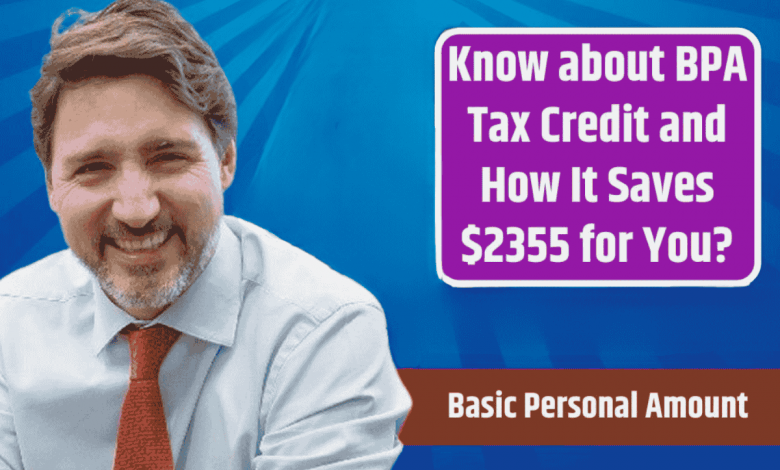What is BPA Tax Credit and How It Saves $2355 for You?

If you’re a Canadian taxpayer, you might not know about the Basic Personal Amount (BPA) tax credit. This credit can save you up to $2,355 on your taxes each year. It helps increase your disposable income and improve your budgeting. We’ll cover everything you need to know about the BPA tax credit to help you save more.
The BPA tax credit is a key part of the Canadian tax system. It gives tax relief to individuals and families. By learning about who can get it, how to calculate it, and how to use it, you can make the most of this financial tool. It can help you spend more, increase your savings, or strengthen your budget.
Understanding the Basic Personal Amount
The Basic Personal Amount (BPA) is a key tax-free allowance for all Canadian residents. It acts as a financial safety net, making sure a certain income is tax-free. Knowing about the basic personal amount helps you manage your budget better and use this tax deduction wisely.
The basic personal amount gives a basic tax-free income to individuals. It helps reduce your tax burden and keeps more of your spending money. This amount changes every year to keep up with living costs, making sure it still helps taxpayers.
Let’s look at an example: In 2023, the BPA is $14,398. This means the first $14,398 of your income is tax-free. This could save you a lot on your taxes.
“The basic personal amount is a crucial tool in managing your personal finances and maximizing your allowance for discretionary spending.”
Understanding the basic personal amount helps you plan your finances better. It ensures you’re using this valuable tax credit to its fullest.
Eligibility Requirements for the BPA Tax Credit
To get the Basic Personal Amount (BPA) tax credit, you must meet certain requirements. First, you need a valid Social Insurance Number (SIN). Also, your income must be within the limits set by the Canada Revenue Agency (CRA).
Income Thresholds and Limitations
The BPA tax credit has income limits. For 2023, it starts to reduce for those with a net income over $15,000. It ends at $29,590, when the credit is gone. Knowing these limits helps you claim the right amount and avoid CRA problems.
| Filing Status | Income Threshold | BPA Tax Credit Amount |
|---|---|---|
| Single | $15,000 – $29,590 | $13,229 – $0 |
| Married/Common-Law | $15,000 – $29,590 | $26,458 – $0 |
| Single Parent | $15,000 – $29,590 | $19,389 – $0 |
Knowing the income limits helps you claim the right BPA tax credit. This way, you can save more.
Calculating Your BPA Tax Credit
Finding out how much of your BPA tax credit you can get is easy, thanks to the Canada Revenue Agency (CRA). The amount you can deduct depends on your income and the tax rates in your area.
To figure out your BPA tax credit, just follow these steps:
- First, find out your total taxable income for the year.
- Then, look up the tax rates for your income level on the CRA’s website.
- Finally, multiply your income by the tax rates to see your total tax savings.
| Income Level | Federal Tax Rate | Provincial/Territorial Tax Rate | Total Tax Savings |
|---|---|---|---|
| $50,000 | 15% | 10% | $2,355 |
| $75,000 | 20.5% | 12% | $3,975 |
| $100,000 | 26% | 15% | $5,900 |
Learning how to calculate your BPA tax credit helps you manage your money better. It lets you save more on taxes. Knowing about this can improve your financial health.
How the BPA Tax Credit Boosts Your Disposable Income
The Basic Personal Amount (BPA) tax credit can greatly increase your disposable income. It gives you a tax refund, leaving you with more money for your budget and spending. This extra cash lets you manage your finances better.
Budgeting with Your Pocket Money
With the BPA tax credit, you can improve your budget to meet your financial goals. You might save for a big buy, pay off debts, or spend more freely. The BPA credit helps you make smarter choices with your money.
| Without BPA Credit | With BPA Credit |
|---|---|
| Disposable Income: $3,000 | Disposable Income: $3,355 |
| Savings: $500 | Savings: $600 |
| Discretionary Spending: $1,000 | Discretionary Spending: $1,155 |
| Debt Repayment: $1,500 | Debt Repayment: $1,600 |
The BPA tax credit can increase your disposable income by up to $355. This means you can save more, spend on what you want, or pay off debts faster. This extra money can greatly improve your financial health.
Knowing how the BPA tax credit affects your budget helps you spend smarter. It lets you plan your finances better, boosting your financial security and improving your life quality.
Basic Personal Amount and Your Personal Budget
Adding the Basic Personal Amount (BPA) tax credit to your budget can change how you manage money. This credit can greatly affect how much you spend and save. It lets you use your money better.
Knowing how the BPA tax credit fits into your budget helps you make smart money choices. It ensures your budget matches your goals. Let’s see how this credit can improve your budgeting and use of disposable income.
Budgeting with Your Pocket Money
The BPA tax credit can increase your spending money. Here’s how to add it to your budget:
- Figure out how much BPA tax credit you’ll get based on your income and eligibility.
- Put the extra money from the credit into your budget, like for spending, saving, or paying off debt.
- Watch how the credit changes your finances and adjust your budget as needed.
By managing the BPA tax credit well, your budget will truly reflect your finances. It will also help you reach your financial goals.
“Integrating the BPA tax credit into your personal budget can be a game-changer for managing your finances.”
Optimizing Your Discretionary Funds
The BPA tax credit can also boost your discretionary funds. This lets you spend more on what’s important to you. By looking at your budget and moving funds around, you can live better without hurting your finances.
Remember, the BPA tax credit is a powerful financial tool. Understanding its role in your budget helps you control your spending, saving, and investing. This leads to a more secure and fulfilling financial future.
Maximizing Your Spending Money with the BPA Tax Credit
As a smart Canadian, you can boost your spending by using the Basic Personal Amount (BPA) tax credit. This strategy lets you use your funds wisely and reach your financial goals. Here are some tips to make the most of the BPA tax credit.
Smart Strategies for Utilizing the Credit
To maximize the BPA tax credit and increase your spending, try these tips:
- Check your income and see if you qualify for the full BPA tax credit. Know the income limits to get the most out of it.
- Add the expected BPA tax credit to your budget. Use it for things you want or save it for later.
- Look into investments that grow your spending money over time. Use the BPA tax credit to improve your returns.
- Keep an eye on any changes to the BPA tax credit. This could affect your financial plans and strategies.
By using these smart strategies, you can maximize the BPA tax credit. This way, your money works better for your financial health and lifestyle.
“Utilizing the BPA tax credit is a game-changer for Canadians looking to stretch their spending money and achieve their financial goals.”
BPA Tax Credit and Tax Planning
The Basic Personal Amount (BPA) tax credit is a key part of your financial planning. It can affect your taxable income and tax liability. Knowing how it works can help you make better decisions about your money.
Good tax planning can make the most of the BPA tax credit. This means you might pay less in taxes. With more money, you can save for retirement, pay off debt, or invest in your future.
- Use the BPA tax credit in your tax planning to lower your taxable income and taxes.
- See how the BPA credit works with other tax strategies, like income-splitting, to save even more on taxes.
- Think about how the BPA credit affects your cash flow. Use this info to plan your budget and investments.
| Tax Planning Strategies | Potential Benefits |
|---|---|
| Maximizing the BPA tax credit | Reduces your taxable income and lowers your overall tax burden |
| Integrating the BPA credit with other deductions and credits | Optimizes your tax situation and increases your available funds |
| Aligning the BPA credit with your financial goals | Helps you allocate your resources more effectively and boost your discretionary income |
“Effective tax planning is essential for maximizing the benefits of the BPA tax credit and ensuring your financial well-being.”
Adding the BPA tax credit to your tax and financial plans can help you use this credit fully. It can set you up for long-term financial success.
The Impact of the BPA Tax Credit on Your Discretionary Funds
The Basic Personal Amount (BPA) tax credit does more than just lower your taxes. It also boosts the money you have for fun and personal spending. Knowing how it changes your income lets you plan better and spend wisely.
Getting the BPA tax credit means you get more money in your pocket. This extra cash can be a big help in your budget. You can use it for anything, like a weekend trip, a new gadget, or a night out with friends.
This extra money can also help you in the long run. With more cash, you might save more, pay off debt, or invest in your future. This can lead to a more stable financial life and a better quality of life.
“The BPA tax credit has given me the freedom to enjoy a few more little luxuries without feeling guilty about splurging. It’s like a personal reward for being a responsible taxpayer.”
To use the BPA tax credit well, know your budget and spending habits. Keep track of your money and find ways to spend less. Then, use the extra money from the credit for things that make you happy and fulfilled.
The BPA tax credit is more than saving on taxes. It gives you the chance to live a richer life by letting you spend on what you love. Use this credit to explore new things and make your life more exciting and complete.
Comparing the BPA Tax Credit with Other Tax Allowances
The Basic Personal Amount (BPA) tax credit is just one of the deductions Canadians can use for tax planning. It’s key to know how it stacks up against other tax credits and allowances. This helps you make the most of your tax savings.
The Canada Caregiver Credit is another big one. It gives a tax credit to those caring for a dependent with a physical or mental issue. This credit can add to the BPA tax credit, especially for those caring for others.
Don’t forget about the Disability Tax Credit. It offers a big tax break for people with severe disabilities. You can claim this credit along with the BPA, giving you more tax relief if you qualify.
| Tax Allowance | Maximum Credit/Deduction | Eligibility Requirements |
|---|---|---|
| Basic Personal Amount (BPA) | $14,398 (2023) | Available to all Canadian taxpayers |
| Canada Caregiver Credit | $7,525 (2023) | Caring for a dependent with a physical or mental impairment |
| Disability Tax Credit | $8,870 (2023) | Severe and prolonged physical or mental impairment |
Knowing the differences and who can get these tax allowances helps Canadians use all the deductions and credits they can. This way, they can save more on taxes and improve their financial health.
Common Misconceptions About the Basic Personal Amount
Many people get confused about the Basic Personal Amount (BPA) tax credit. This confusion can lead to mistakes when claiming the deduction. We’ll clear up these misunderstandings. This will give you a clear view of how the BPA tax credit works and its benefits for Canadian taxpayers.
Myth 1: The BPA Tax Credit is a Flat Amount
Many think the BPA tax credit is always the same for everyone. But, it changes every year because of inflation. It also depends on how much you make. The amount you can claim goes down at higher incomes, so it’s key to know the rules.
Myth 2: The BPA Tax Credit is for Individuals Only
Some believe the BPA tax credit is just for single people. But, it’s also for married couples, common-law partners, and those with dependents. Knowing who can get it is important to get the most from the BPA tax credit.
Myth 3: The BPA Tax Credit is Limited to Federal Taxes
Some think the BPA tax credit only helps with federal taxes. But, it can also lower your tax deductions at the provincial or territorial level. This means you could save more on your taxes overall.
By understanding these myths, you can better use the BPA tax credit system. This ensures you’re getting all the deductions and savings you can as a Canadian taxpayer.
| Myth | Reality |
|---|---|
| The BPA Tax Credit is a Flat Amount | The BPA Tax Credit is adjusted annually and subject to phase-out at higher income levels. |
| The BPA Tax Credit is for Individuals Only | The BPA Tax Credit can be claimed by individuals, married couples, common-law partners, and those supporting eligible dependents. |
| The BPA Tax Credit is Limited to Federal Taxes | The BPA Tax Credit can be used to reduce both federal and provincial/territorial tax deductions. |
“Understanding the myths and realities of the BPA tax credit is crucial to maximizing your tax savings as a Canadian taxpayer.”
The Future of the BPA Tax Credit
The Basic Personal Amount (BPA) tax credit has been a big help for Canadians for years. But, like all government programs, it’s always under review for changes. Keeping up with updates and reforms can help you plan your money better.
Proposed Changes and Reforms
There’s talk about possibly increasing the BPA tax credit amount. Lawmakers want to give Canadians more savings. They’re also looking at changing who gets the credit and how much they get.
It’s important to keep an eye on these changes. This way, you can make the most of the BPA tax credit and plan your money well.
| Proposed Changes | Potential Impact |
|---|---|
| Increase in BPA Allowance Amount | Greater tax savings for eligible taxpayers |
| Adjustments to Income Thresholds | Expanded eligibility or modified phase-out range |
The BPA tax credit is always changing, so it’s key to stay informed. Knowing about possible changes helps you use this tax credit to its fullest. This way, you can improve your finances.
“The BPA tax credit is a crucial tool for Canadians looking to boost their disposable income and achieve their financial goals. As the government explores potential reforms, it’s essential to stay informed and prepared for any changes that may come.”
Expert Tips for Making the Most of Your Cash on Hand
Getting the most from the Basic Personal Amount (BPA) tax credit starts with smart budgeting and spending. Our financial experts offer top tips to use your cash wisely.
Start by making a detailed budget that covers your bills, fun money, and savings goals. This helps you see where your money goes and lets you use your BPA tax credit well. Think about putting some extra cash into savings or investments to grow your wealth over time.
Also, find smart ways to use your cash, like paying off high-interest debt or upgrading your home to save on energy costs. Spending wisely helps you use the BPA tax credit better and keeps your budget in check.
FAQ
What is the Basic Personal Amount (BPA) tax credit?
The Basic Personal Amount (BPA) is a tax-free amount you can claim on your tax return. It helps ensure you have some income that’s not taxed. This boosts your money for personal spending and budgeting.
Who is eligible for the BPA tax credit?
You need to be a Canadian resident and have a valid Social Insurance Number (SIN) to get the BPA tax credit. The credit has income limits and rules based on your filing status and other factors.
How do I calculate my BPA tax credit?
Your BPA tax credit amount depends on your income and tax rates. The Canada Revenue Agency (CRA) offers guidelines and methods to figure out your credit.
How does the BPA tax credit boost my disposable income?
The BPA tax credit adds money to your disposable income. This lets you spend more on what you want. Knowing how it affects your money helps you manage your budget better.
How can I maximize the benefits of the BPA tax credit?
Use smart budgeting, investment, and tax planning to get the most from the BPA tax credit. Understanding how it affects your taxes helps you make better financial decisions.
How does the BPA tax credit compare to other tax allowances?
The BPA tax credit is a key deduction, but it’s good to know how it stacks up against other credits in Canada. Comparing it to credits like the Canada Caregiver Credit helps you use all tax benefits you’re eligible for.
What are some common misconceptions about the BPA tax credit?
Many people misunderstand the Basic Personal Amount tax credit, leading to confusion. It’s crucial to clear up these misconceptions for a clear understanding of the credit and its benefits.
What is the future of the BPA tax credit?
The government reviews the Basic Personal Amount tax credit regularly, which could lead to changes. Staying updated on any updates or reforms helps you plan your finances better.
What expert tips can help me make the most of my cash on hand?
We’ve gathered expert advice to help you use the BPA tax credit and your cash wisely. These tips cover budgeting and investing to maximize the credit’s benefits and manage your money well.



